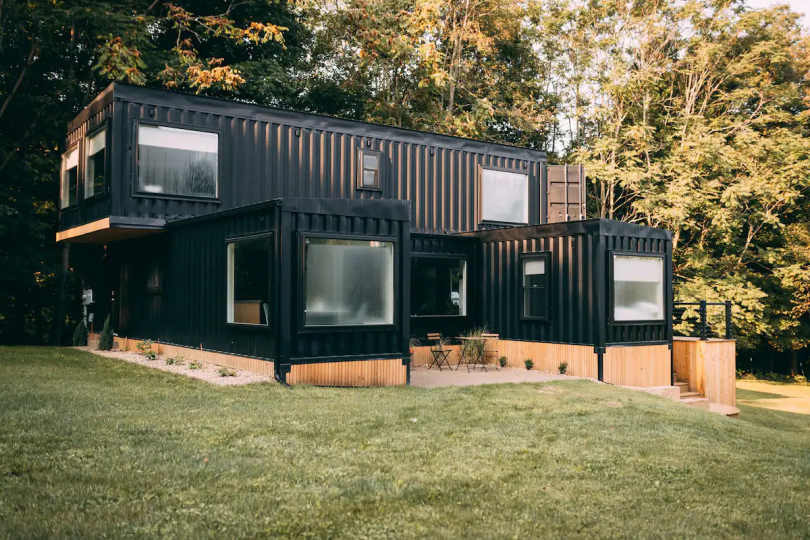As the name implies, container homes are exactly what they sound like. They are homes constructed from steel shipping containers; the same containers that are commonly used to transport goods around the world by train, truck, and ship. People have begun developing homes created from these giant lego block style containers and combining them to create homes of all different shapes and sizes.
Shipping containers are generally available in lengths of 10 feet, 20 feet or 40 feet. A small shipping container can provide around 100 square feet of space for your shipping container home. You could make a 1400 square foot 2 story home by putting together 8 large shipping containers. You could even put together a few hundred smaller containers to make a little apartment complex creating a micro apartment community.
Why are shipping containers being used to create homes and offices you might ask? Well, with a huge surplus of roughly 14 million containers that are out of service, there certainly are plenty of them available for use. Besides, who doesn’t enjoy being able to play with giant blocks?
Using shipping containers to create your home isn’t just the cool new trendy thing to have right now; they are also part of a wider interest to save money by using prefabricated and modular type homes. Many would-be homeowners are looking for a home that has lower construction costs and is easier to maintain. Many people also associate the use of a container home as contributing to recycling and going green.
Are you considering a container home and wondering if it would make a good fit for you? Let’s take a look at some of the pros and cons of owning a shipping container home.
Table of Contents
Shipping Container Homes (Pros)
Prefab Shipping Container Homes
Many of the current container homes are available as a prefabricated modular home that can cut down on construction times. There are even companies advertising delivery availability within 10 weeks of order placement. Building code inspections are generally handled at the factory allowing for a faster and more streamlined process. If you are looking to create a customized home or a fun DIY project, the container can provide you with a fun pre-built structure to play around with.
Easy To Transport
There is already a system in place to easily transport moving containers around the world. Once they’ve reached your build site they are fairly easy to get set up on the home’s prepared foundation.
Container Homes Have A Predictable Cost
Most work is handled for a fixed price at the factory. The only variable costs would be the home’s site delivery fees, the site preparation, foundation creation and any utility connections. With this in mind, shipping container homes may not always be the cheapest option. While estimations can vary, the savings are generally around 5-10% depending on what it’s being compared against.
Go Green With A Recycled Shipping Container Home
There is a certain environmental appeal that comes with owning a container home. It’s a great concept where one can use a leftover shipping container to create a home that was previously purposed for the shipping industry.
Container homes can benefit from the worldwide infrastructure in place that handles the transport of shipping containers. Even skeptics of container homes know they can be useful in situations where local building expertise isn’t very strong or there is a need for emergency shelters that need to be moved easily. With these types of situations, the versatility of a container transport is a really big advantage.
Often marketed as being an environmentally friendly alternative, container homes can be made from old and used containers that are no longer in circulation and be repurposed to create a cool trendy style home.
Shipping Container Homes (Cons)
Shipping Container Homes Are Not Always Recycled Effectively
Many of the factory built shipping container homes are built from containers that have only had one trip before. These types of containers are generally in good condition and don’t have the dents or rust associated with the more used shipping containers making them great to build with. Taking a shipping container out of circulation after only a single trip however isn’t really effective recycling. There’s likely more steel in a single shipping container than you could possibly need to build an actual home.
There Is A Higher Chance For Structural Issues
Shipping containers tend to be very strong at the corners but the roof on the other hand is not particularly strong. You will typically need to build another roof over the existing container’s top, especially if you are expecting snow. Keep in mind that the corrugated steel walls are critical to maintaining the integrity of the structure. This essentially means that if you cut out a window or new doorway there will be additional reinforcement required. If you are planning to stack multiple containers together to create a larger home, be aware that welded reinforcement will be required.
How Safe Are Shipping Container Homes?
It’s not always possible to know the container’s history and what exactly had been previously shipped inside it. It could range from anything like harmless consumer goods up to hazardous industrial materials that are toxic. You won’t know what the container has been through before. Sometimes the paints or finishes on these containers may contain toxic elements like lead as the containers were originally meant for transport across the oceans and not for use as a residential home.

I don’t think the title of your article matches the content lol. Just kidding, mainly because I had some doubts after reading the article. https://www.binance.com/pt-BR/join?ref=YY80CKRN